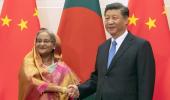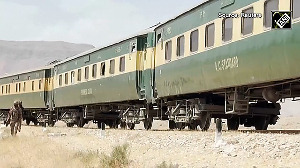Piyush Goyal, the minister for commerce, said in an interview the other day that he could not understand how a cheaper rupee would help when the country had a large trade deficit.
For an answer, he should look at how trade numbers evolved after the 1966 rupee devaluation. Exports grew with a time lag, while imports contracted, says T N Ninan.

When domestic demand is slack, competitive economies look to export markets.
Indeed, every country that has grown rapidly has been a successful exporter.
One of the fundamental reasons for the slowdown in India in recent years has been the failure to generate export momentum, especially merchandise exports. So exports have fallen significantly in relation to GDP.
The economy cannot work its way out of the current slump without reversing these trends and achieving an export boost.
Yet, almost all the talk is about import substitution (which is fine if done efficiently) and raising tariffs (which suggests it is not).
Sceptics say an export thrust is difficult when global trade is not doing well. But the garment trade, too, is stagnant. Yet Vietnam, Indonesia, and Cambodia have recorded rapid export growth, and Bangladesh has continued to pull ahead of India.
The reason is that they have stepped into China’s shoes. Beijing used to export $20 billion worth of garments every month; that is down to $12 billion (a figure that India takes nearly nine months to achieve). The slack has been taken up mostly by East Asia and Bangladesh, and to a relatively minor degree by India.
Bangladesh used to export only 60 per cent of what India did; now it exports twice as much. Vietnam too has overtaken India and is now comfortably ahead. The irony is that Bangladesh sources cotton, yarn, and fabrics from India!
Garment exports offer a solution to complex problems, beyond helping to narrow the trade deficit. It is more employment-intensive than any other large industry, by a long shot -- 10-fold or more when compared to the automobile/engineering sector, and perhaps 100-fold when it comes to chemicals and petrochemicals.
Much of the industry’s sales turnover therefore goes towards wages -- which boosts domestic consumption demand (an important consideration just now).
Further, most employees in the industry are women -- whose reduced participation in the labour force has become a matter of concern.
Since the textiles/garments sector already accounts for about a third of total manufacturing employment, promoting garment exports could provide the single-greatest boost to jobs in manufacturing.
The opportunity is still there, because Chinese exporters face the threat of US tariff hikes (not yet applied to garments), rising costs, and wafer-thin margins.
India’s handicap is an unlevel playing field; Bangladesh as a “least-developed country” enjoys duty-free access to markets in Europe, Canada, and Japan.
Vietnam and Sri Lanka do the same with Europe because of free-trade agreements (FTA).
Bangladesh’s tariff-free access to Europe expires in 2024, but it too might sign an FTA.
In a thin-margin business, a 10 per cent tariff handicap is a killer.
India has balanced trade flows with the European Union, but continues to hold back from an FTA -- partly because of lobbying by Japanese car companies in India.
In recent years the government has helped by introducing flexible labour rules and contributing to provident fund accounts (thus partially closing the wage gap with Bangladesh).
Its latest offer, of a 17 per cent tax rate to new manufacturing outfits, closes another gap.
But exporters have to run other gauntlets, like poor infrastructure and time-consuming port processes. Equally important is correction of the rupee’s over-valuation.
Piyush Goyal, the minister for commerce, said in an interview the other day that he could not understand how a cheaper rupee would help when the country had a large trade deficit.
For an answer, he should look at how trade numbers evolved after the 1966 rupee devaluation. Exports grew with a time lag, while imports contracted.
A massive trade gap was reduced by over 80 per cent in four years.
Similarly, the five-year average trade deficit before the 1991 devaluation was 40 per cent of exports, but fell off after the devaluation and then stayed relatively low for more than a decade.
Sharp devaluations are not possible today, since the US monitors countries that it considers to be currency manipulators, but there is more than one way to skin the cat.
A correction of the rupee’s bloated value is not only feasible, it is urgently required if rapid export growth is to return.












 © 2025
© 2025